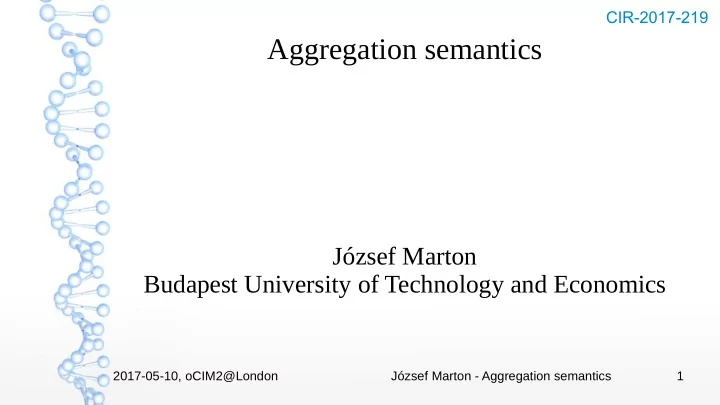

CIR-2017-219 Aggregation semantics József Marton Budapest University of Technology and Economics 2017-05-10, oCIM2@London József Marton - Aggregation semantics 1
Aggregation in openCypher Partition tuples based on values for grouping key ● Return a single resulting tuple for each partition ● In openCypher: WITH/RETURN clauses ● E.g. count nodes in each class (.class property) ● MATCH (n) RETURN n.class, count(*) 2017-05-10, oCIM2@London József Marton - Aggregation semantics 2
Implicit grouping key Result definition of a query (step) defines aggregation ● Neo4j 3.1 docs tells ● RETURN n, count(*) We have two return expressions: n, and count(*). The first, n, is not an aggregate function, and so it will be the grouping key. The latter, count(*) is an aggregate expression. What if mixing aggregate and non-aggregate ● expressions, e.g. the weighted sum query RETURN n.weight * sum(n.value) 2017-05-10, oCIM2@London József Marton - Aggregation semantics 3
CIR-2017-219 Grouping key selection options RETURN n.weight * sum(n.value) 1. grouping key is the tuple built from all variables (*) that appear outside of aggregate functions of a particular WITH/RETURN clause *: node, relationship, their properties or variables chained from previous query step Pros: clear in all situations, more flexible than option 2 Cons: would change current Neo4j behavior 2. each item of the expression list in WITH/RETURN forced to contain either i no aggregate function, or ii single aggregate function at the outermost level (this is the approach in #188, #218). Grouping key is the tuple built from items of type (i), i.e. those w/ no aggregates Pros: in line with current Neo4j behavior and the grouping operator in Ullman‘s Database systems -- The complete book, 2009 Cons: poses restriction on WITH/RETURN clauses, can‘t handle the weighted sum query w/o rewriting as WITH n.weight as weight, sum(n.value) AS sum_val RETURN weight * sum_val 2017-05-10, oCIM2@London József Marton - Aggregation semantics 4
CIR-2017-219 TODO: Choose Neither option restrict expressiveness ● might need some query rewrite Option 1 seems clear and flexible enough for practical queries ● Option 2 is in Neo4j, but complex aggregation and non- ● aggregation expressions might yield counter-intuitive result Posing restrictions on creating complex expressions by mixing aggregations and non-aggregations is a safety net for beginners, but cumbersome for more complex queries. 2017-05-10, oCIM2@London József Marton - Aggregation semantics 5
Feel the difference M A T C H ( n ) Input graph: R E T U R N a b s ( n . w e i g h t ) A S a b s , c o u n t ( * ) A S c n t ten nodes: two for each weight -2,-1,0,1,2 Option2 gives: Option1 gives: ╒═════╤═════╕ Model Opt.2 in Opt1 ╒═════╤═════╕ │"abs"│"cnt"│ │"abs"│"cnt"│ ╞═════╪═════╡ ╞═════╪═════╡ │"2" │"4" │ │"2" │"2" │ ├─────┼─────┤ M A T C H ( n ) ├─────┼─────┤ │"1" │"4" │ W I T H a b s ( n . w e i g h t ) A S a b s , n │"1" │"2" │ ├─────┼─────┤ R E T U R N a b s , c o u n t ( * ) a s c n t ├─────┼─────┤ │"0" │"2" │ │"2" │"2" │ └─────┴─────┘ ├─────┼─────┤ │"0" │"2" │ ├─────┼─────┤ │"1" │"2" │ └─────┴─────┘ 2017-05-10, oCIM2@London József Marton - Aggregation semantics 6
CIR-2017-219 Let‘s get loud 1. grouping key is the tuple built from all variables (*) that appear outside of aggregate functions of a particular WITH/RETURN clause *: node, relationship, their properties or variables chained from previous query step 2. each item of the expression list in WITH/RETURN forced to contain either i no aggregate function, or ii single aggregate function at the outermost level (this is the approach in #188, #218). Grouping key is the tuple built from items of type (i), i.e. those w/ no aggregates 2017-05-10, oCIM2@London József Marton - Aggregation semantics 7
That‘s all 2017-05-10, oCIM2@London József Marton - Aggregation semantics 8
Recommend
More recommend